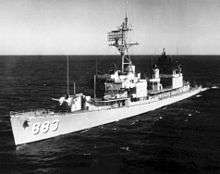USS Newman K. Perry (DD-883)
_underway.jpeg) | |
| History | |
|---|---|
| Name: | USS Newman K. Perry |
| Builder: | Consolidated Steel Corporation, Orange, Texas |
| Laid down: | 10 October 1944 |
| Launched: | 17 March 1945 |
| Commissioned: | 26 July 1945 |
| Decommissioned: | 27 February 1981 |
| Struck: | 27 February 1981 |
| Fate: | Transferred to South Korea, 1981 |
| Name: | ROKS Kyong Kai |
| Acquired: | 1981 |
| Decommissioned: | 1997 |
| Fate: | Scrapped, 1999 |
| General characteristics | |
| Class and type: | Gearing-class destroyer |
| Displacement: | 2,425 long tons (2,464 t) |
| Length: | 390 ft 6 in (119.02 m) |
| Beam: | 40 ft 10 in (12.45 m) |
| Draft: | 18 ft 6 in (5.64 m) |
| Propulsion: | Geared turbines, 2 shafts |
| Speed: | 35 knots (65 km/h; 40 mph) |
| Complement: | 345 |
| Armament: |
|
USS Newman K. Perry (DD–883/DDR–883), a Gearing-class destroyer was the only ship of the United States Navy named for Ensign Newman K. Perry, USN (1880–1905), who was killed in a boiler explosion board Bennington on 21 July 1905.
Perry was laid down by the Consolidated Steel Corporation at Orange, Texas on 10 October 1944, launched on 17 March 1945 by Mrs. Laura P. Gunter, sister of Ensign Perry and commissioned on 26 July 1945, Commander Norman E. Smith in command.
Service history
1945–1949
Following shakedown, Newman K. Perry served briefly with the Atlantic Fleet. On 7 November 1945, she got underway for Pearl Harbor, whence she sailed to Japan for three month's occupation duty. She returned to Pearl Harbor on 28 March 1946 and was assigned to Joint Task Force 1 for "Operation Crossroads", the 1946 atomic bomb test series at Bikini. Sailing for the Marshall Islands on 27 May, she witnessed tests "Able" and "Baker" and, in August, steamed for the United States.
On 18 August she arrived at San Diego whence she operated until 25 August 1947. Then, with DesDiv 132, she headed west, arriving at Yokosuka on 13 September. Three days later she sailed to Tsingtao to commence a series of patrol, escort, search and rescue, ASW, and hydrographic survey missions and exercises along the China coast and off Taiwan and Okinawa. Relieved on 5 May 1948, she returned to San Diego, trained naval reservists through the summer and in October entered the Mare Island Naval Shipyard for overhaul.
The destroyer departed San Francisco on 15 January 1949 and until April conducted exercises off the west coast. On 4 April, she departed San Diego with DesDiv 182 for Newport, Rhode Island, her new homeport, arriving 21 April.
1950–1968
After her return to Destroyer Forces, Atlantic Fleet, she rotated tours with the 6th Fleet in the Mediterranean Sea and midshipmen and reservist training cruises, and fleet, squadron and type training exercises with the 2nd Fleet. Redesignated a radar picket destroyer in 1950, she conducted her scheduled operations as DDR–883 until 1964 when Newman K. Perry underwent the FRAM I refit at the Boston Naval Shipyard until February 1965. The most visible alteration were the new bridge, the addition of a hangar and landing deck aft for the Gyrodyne QH-50 DASH drone and the addition of an ASROC launcher between the funnels. Modernized into a "regular" destroyer again, she resumed the designation DD-883.
On October 1965 she collided with the aircraft carrier Shangri-La in the Mediterranean, killing one and injuring another. A change in operations in 1959 took her to Charleston, South Carolina, which served as her homeport for several years before she resumed operations out of Newport.

A second change in operations took her to the Western Pacific for her overseas deployment in 1966. Departing Newport with Destroyer Division 201 on 4 October, she transited the Panama Canal, stopped in Hawaii, Japan, Okinawa and the Philippines, and arrived on station in the Mekong Delta of South Vietnam on 23 November. Assigned to fire support duties, she shelled enemy coastal storage areas until the 28th. She then shifted to Phú Quốc island, off the Cambodian-South Vietnamese border, to support Vietnamese and Special Forces units for five days, returning to the Delta area in December. Other assignments on that tour with the 7th Fleet took her along the coast to the DMZ and then to the Gulf of Tonkin for plane guard and search and rescue missions. On 8 March 1967, she departed the combat zone for Hong Kong before returning to Subic Bay for the last time. On the 27th she departed the Philippines for the Mediterranean and Newport, arriving on 8 May.
After overhaul at Boston, Newman K. Perry began 1968, with Caribbean exercises and on 4 April departed Newport for the Mediterranean to resume her annual deployments with the 6th Fleet.
1969–1981
Newman K. Perry was decommissioned and stricken from the Naval Vessel Register on 27 February 1981.
ROKS Kyong Kai
Newman K. Perry was transferred to South Korea in 1981 for service in the Republic of Korea Navy and renamed ROKS Kyong Kai. South Korea decommissioned Kyong Kai in 1997. She later was damaged by fire and scrapped in 1999.
References
- This article incorporates text from the public domain Dictionary of American Naval Fighting Ships. The entry can be found here.
- This article includes information collected from the Naval Vessel Register, which, as a U.S. government publication, is in the public domain. The entry can be found here.
External links
| Wikimedia Commons has media related to USS Newman K. Perry (DD-883). |
- Photo gallery of USS Newman K. Perry at NavSource Naval History